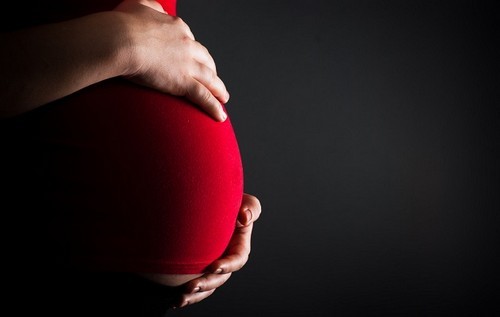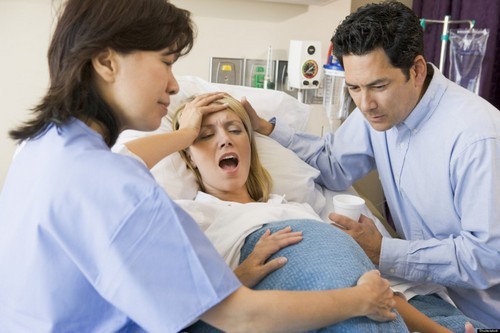The period of pregnancy is quite difficult for a woman. At this time, the body experiences severe stress, a significant part of the trace elements and vitamins go to the formation of the fetus.
Therefore, unsurprising problems such as : hair loss, brittle nails, deterioration of the skin.
Also, due to a deficiency of the necessary elements, all kinds of diseases can develop, among which the nail fungus is one of the most common.
What is nail fungus?
This disease can cause a person suffering from it, a lot of trouble. Fungal lesions eventually cause deformation of the nail plate.
If they are not treated, then soon you can find signs of the disease on the remaining nails.
Fungal lesions, in fact, are an accumulation of harmful microorganisms that negatively affect the body’s immune system, can provoke allergic reactions.
Views
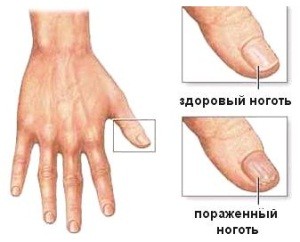
Usually, nail fungus is divided into two main groups:
- Onychomycosis. This group includes all nail lesions with fungi of different species. In particular, dermatophytes, yeast-like fungi, molds, etc.
- Mycosis. This group includes only problems caused by dermatophyte fungi.
Sometimes both names may indicate the same disease, so a similar division into two groups is considered conditional.
Forms of fungal lesions
Nail fungus can occur in the following forms:
- Distal subungual onychomycosis. This type is one of the most common. The disease forms in the distal region of the nail (at its tip), then gradually spreads to the entire plate, reaching the root. The main signs of this form: white, yellowish or yellow-gray spots on the surface of the nail.Over time, the nail plate may become dirty gray, the surface of the nail itself may lose uniformity, begin to crumble. Sometimes the nail thickens or, conversely, becomes very thin. In a particularly severe case, it can completely crumble.This disease is most often caused by fungi of the following species: Trichophyton rubrum, Trichophyton mentagrophytes var. Interdigitale, Epidermophyton floccosum.
- Proximal subungual onychomycosis. This disease is quite rare. As a rule, it first affects the skin around the nail plate, and then spreads to the nail itself. In places of damage, the surface usually delaminates and crumbles.The cause of this disease is the following fungi: Trichophyton rubrum, Trichophyton megninii, Trichophyton schoenleinii, Trichophyton tonsurans, Trichophyton mentagrophytes var. Interdigitale.
- Superficial white onychomycosis. With this disease, the main damage to the nail is observed in the center of the plate or along the edges. Also, white spots gradually spread throughout the surface. This type of fungus occurs only on the toenails.Since the infection in this case is located on the upper part of the plate, the nail itself is not deformed. However, if the disease is not treated, then over time the entire plate may be destroyed.In the presence of this disease, the nail to the touch seems loose and rough. This type of fungus is caused by the following pathogens: Trichophytonmentagrophytesvar. Interdigitale, rubrum, Trichophytonviolaceum.
Other forms of onychomycosis are possible, therefore, for the most effective treatment, you should consult a doctor and pass the necessary tests that will reveal the pathogen fungus.
Main stages
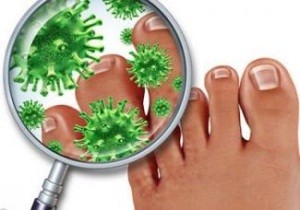
Doctors distinguish three stages of the development of this disease.
- First stage. It is characterized by the absence of any pronounced symptoms. On the nail plate, only faint spots or stripes can be distinguished. At this stage, onychomycosis can be diagnosed only by the results of medical tests.
- The second stage is characterized by the loss of gloss by the nails, as well as a noticeable change in the shade of the plate. Deformation of the lateral region of the nail or the upper is possible.
- Third stage. At this stage, delamination of the nail plate is likely. She may start to crumble.
Unlike the earliest stage, the second and third can be easily diagnosed independently. It is only necessary to carefully examine the nails.
If the plates become yellowish or grayish, become noticeably more fragile and brittle, then this is more than likely a fungal infection.
Diagnostics
Diagnosing nail fungus is best according to the results of a laboratory study.
The second diagnostic method is visual. The doctor examines the patient’s nails and, based on the signs, makes a diagnosis.
Symptoms and signs of the disease
It is necessary to carefully examine the feet, special attention should be paid to the interdigital folds, where the disease most often originates.
If in these places there are noticeable peeling of the skin and redness, then there is a chance that this is a sign of incipient onychomycosis.
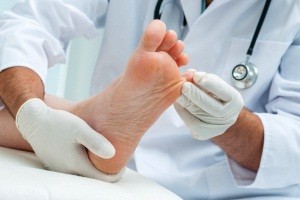
As a rule, the first symptoms appear in the area between the ring finger and little finger. Due to the close arrangement of the fingers in the space between them, sweating is often noted.
The second sign of the disease is itching and severe burning where the skin is affected by the fungus.
You should also pay special attention to the nail plate. A changed shade, a thinned or, conversely, a thickened surface, brittleness – all this indicates the presence of a fungal infection.
However, no matter how obvious the symptoms of the disease may seem, only a doctor can make an accurate diagnosis and only according to the results of the tests.
What is the danger?
Can a fungus on the nails somehow affect the course of pregnancy or the health of the baby?
This disease is not considered dangerous, but it can cause severe inconvenience to the woman herself. Also, the presence of nail fungus in one of the family members creates the prerequisites for the transmission of this disease to others.
Since at this time a woman should not use most of the medications usually prescribed for onychomycosis, it is difficult to get rid of the problem.
However, it is also undesirable to wait until the baby is born. After all, there is a considerable risk to infect the baby with this disease, and it is very difficult to treat newborns.
Treatment features
How and how to treat nail fungus during pregnancy? The doctor should determine the nature of the treatment.
Only a specialist can prescribe the most safe drugs and agents that will help a pregnant woman to alleviate or completely eliminate the disease.
Which specialist should I contact if there is a nail fungus?
Mycologist deals with this problem. It should be addressed to him on the following issues:
- Treatment of diseases of fungal origin that occur on the nails, skin, on the scalp.
- Prevention of these diseases.
- Laboratory studies related to the need for accurate diagnosis of the disease.
If it is not possible to make an appointment with a mycologist, the dermatologist will help to resolve the same issues.
Regardless of the trimester of pregnancy, the treatment of fungus on the nails should be carried out according to one scheme. And the first paragraph should be a mandatory visit to a doctor.
Pregnant women should not be treated with standard oral medications or ointments for external use, as these drugs are absorbed through the blood and can harm the fetus.
Also during pregnancy, laser exposure to areas affected by the fungus is completely prohibited. The only thing that remains permitted is local and mechanical treatment.
As a rule, the scheme of healing from an ailment consists of the following points:
- First you need to soften the affected layers of the skin and nails. This is done using salicylic ointment or petroleum jelly, which are applied to sore spots at night.
- The next day, you should use a soap-soda bath, which is prepared in this way. 2-3 tbsp. tablespoons of laundry soap (grated) must be mixed with the same amount of soda. All this is bred with one liter of warm water. It is by no means hot, since hot water procedures are contraindicated for pregnant women.
- Then, from the affected areas, it is necessary to scrape off the layers of nails infected with the fungus and keratinized parts of the skin.
- After this procedure, you can lubricate the legs with medicines prescribed by your doctor.
Then you need to pass a series of three tests, the interval between which is 7 days. If all three are negative, then the fungal disease is defeated.
Medications
External medications intended for the treatment of fungus are of the following types : ointments, gels, varnishes, sprays, solutions, dressings, etc. However, almost all of them are prohibited during pregnancy.
All these funds tend to accumulate in the horny tissues of the skin and nails. They can have a significant negative effect on the fetus.
Fortunately, there are still drugs that contain elements of only plant origin. Such funds are quite safe, but in any case, before starting their use, you should consult a doctor.
Folk remedies
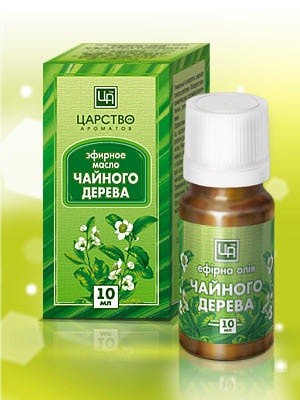
Pregnant women should also be treated with traditional medicine with caution, as some herbs or products are not recommended or even contraindicated.
Among the relatively permitted and safe means are:
- Tea tree oil or tangerine. They can wipe the affected area.
- Propolis solution. Also used for wiping nails. The greatest effect can be achieved if propolis moisten a cotton swab and for a while (for a couple of minutes) apply it to the nail affected by the fungus.
- Grapefruit Seed Extract (Cytosept). With this tool, you need to lubricate your nails twice a day.
Nail Fungus – Doctors Program
Diet
The basic principles of nutrition with the existing fungal infection of the nails are as follows:
- Complete exclusion from the diet of all foods containing sugar.
- Eating starchy foods, as well as having a lot of fiber in the composition.
- Limiting the use of sweet fruits.
- Grains are allowed. Oatmeal is particularly preferred.
- You need to eat a lot of vegetables (both raw and cooked).
- It is important to drink plenty of water (up to two liters per day).
- Recommended herbal teas, mineral water.
- It is necessary to use vitamins and minerals. Particular attention should be paid to calcium.
Prevention
The preventative measures described below are not limited to pregnancy. They should always be respected, regardless of whether the person has suffered from fungal diseases or not.
In public places, don’t wear someone else’s shoes (especially on bare feet).
Shoes should be of high quality material, hygroscopic, strictly in size. It should also be well ventilated. Periodically, it must be treated with a special antifungal spray.
During pregnancy, it is advisable to wear socks or tights strictly from natural materials. For example, from cotton. It is important to change these elements of the wardrobe every day.
You should drink vitamin complexes and strengthen immunity by any means.
Fermented milk products have a good effect on the body. They help strengthen the body’s defenses.
Nail fungus can be treated even in such a difficult period as pregnancy. But it is important to consult a doctor before starting any therapeutic action , and then follow all his instructions so as not to inadvertently harm the baby.

